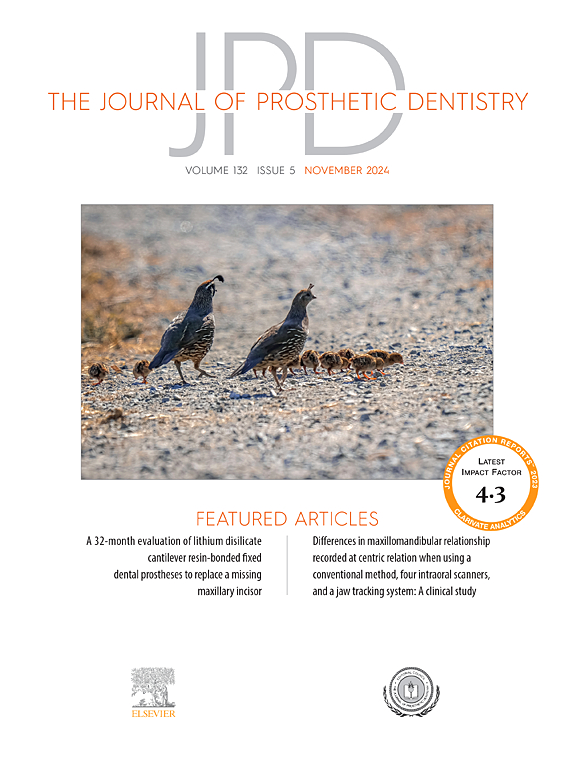Effect of cement space settings on the marginal and internal fit of 3D printed definitive resin crowns
IF 4.3
2区 医学
Q1 DENTISTRY, ORAL SURGERY & MEDICINE
引用次数: 0
Abstract
Statement of problem
The cement gap setting affects the marginal and internal fits depending on the crown material and manufacturing method (subtractive or additive manufacturing). However, information on the effects of cement space settings in the computer-aided design (CAD) software program, which is used to aid the manufacturing with 3-dimensional (3D) printing-type resin material, is lacking, and recommendations for optimal marginal and internal fit are needed.
Purpose
The purpose of this in vitro study was to evaluate how cement gap settings affect the marginal and internal fit of a 3D printed definitive resin crown.
Material and methods
After scanning a prepared typodont left maxillary first molar, a crown was designed with cement spaces of 35, 50, 70, and 100 μm by using a CAD software program. A total of 14 specimens per group were 3D printed from definitive 3D printing resin. By using the replica technique, the intaglio surface of the crown was duplicated, and the duplicated specimen was sectioned in the buccolingual and mesiodistal directions. Statistical analyses were performed using the Kruskal–Wallis and the Mann–Whitney post hoc tests (α=.05).
Results
Although the median values of the marginal gaps were within the clinically acceptable limit (<120 μm) for all the groups, the smallest marginal gaps were obtained with the 70-μm setting. For the axial gaps, there was no observed difference in the 35-, 50-, and 70-μm groups, and the 100-μm group showed the largest gap. The smallest axio-occlusal and occlusal gaps were obtained with the 70-μm setting.
Conclusions
Based on the findings of this in vitro study, a 70-μm cement gap setting is recommended for optimal marginal and internal fit of 3D printed resin crowns.
水泥空间设置对3d打印树脂冠边缘和内部配合的影响。
问题说明:根据冠材料和制造方法(减法或增材制造),水泥间隙设置会影响边缘和内部配合。然而,用于三维(3D)打印型树脂材料制造的计算机辅助设计(CAD)软件程序缺乏关于水泥空间设置影响的信息,并且需要提供最佳边缘和内部配合的建议。目的:本体外研究的目的是评估水泥间隙设置如何影响3d打印最终树脂冠的边缘和内部配合。材料和方法:在扫描准备好的左上颌第一磨牙后,使用CAD软件程序设计具有35、50、70和100 μm水泥空间的冠。每组共14个标本用3D打印树脂进行3D打印。采用复制技术复制牙冠凹刻面,并在颊舌和中远端方向对复制标本进行切片。采用Kruskal-Wallis和Mann-Whitney事后检验进行统计学分析(α= 0.05)。结果:虽然边缘间隙的中位数在临床可接受的范围内(结论:基于本体外研究结果,推荐70 μm的水泥间隙设置为3d打印树脂冠的最佳边缘和内部配合。
本文章由计算机程序翻译,如有差异,请以英文原文为准。
求助全文
约1分钟内获得全文
求助全文
来源期刊

Journal of Prosthetic Dentistry
医学-牙科与口腔外科
CiteScore
7.00
自引率
13.00%
发文量
599
审稿时长
69 days
期刊介绍:
The Journal of Prosthetic Dentistry is the leading professional journal devoted exclusively to prosthetic and restorative dentistry. The Journal is the official publication for 24 leading U.S. international prosthodontic organizations. The monthly publication features timely, original peer-reviewed articles on the newest techniques, dental materials, and research findings. The Journal serves prosthodontists and dentists in advanced practice, and features color photos that illustrate many step-by-step procedures. The Journal of Prosthetic Dentistry is included in Index Medicus and CINAHL.
 求助内容:
求助内容: 应助结果提醒方式:
应助结果提醒方式:


